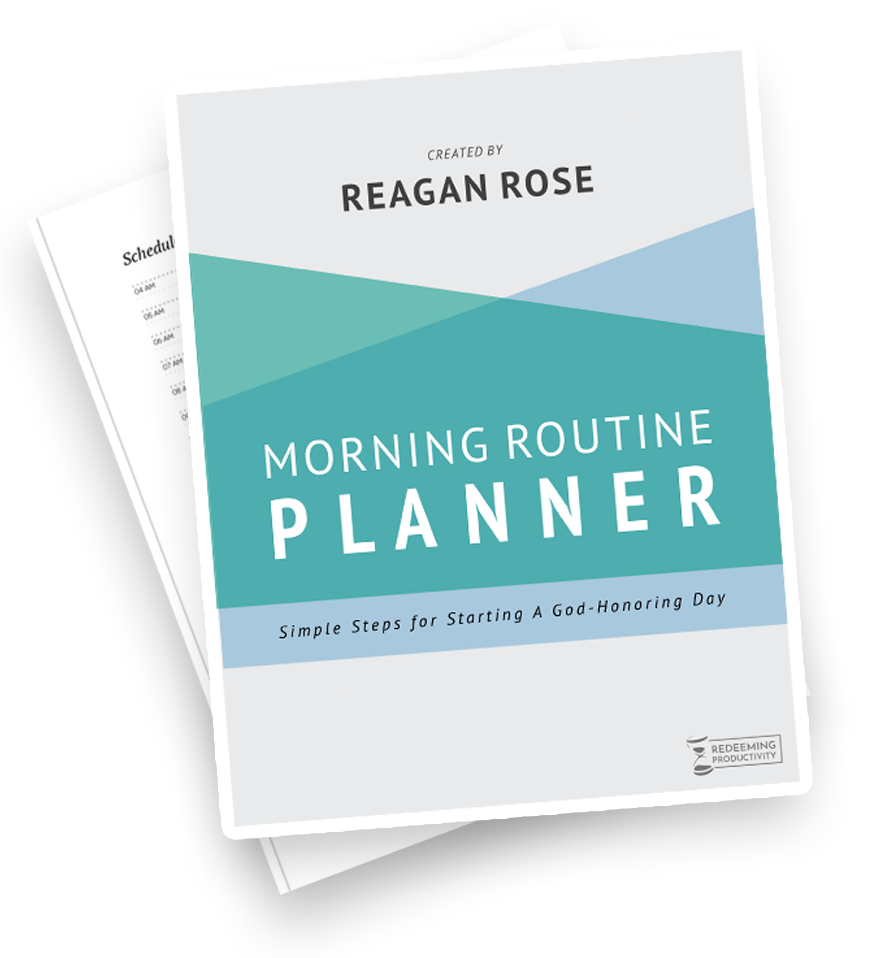For the past decade, I’ve been in the practice of setting annual goals. Every year, around mid-December, I sit down and decide what significant changes, habits, or accomplishments I’d like to seize in the coming twelve months.
The problem with annual goals, however, was that halfway through the year, I’d find the motivation waning like my four-year-old’s interest five minutes after I got all the paint supplies all set up. So, while annual goals are great, I realized that I needed to make my plans a little more bite-sized.
So, a few years ago, I started breaking my years into quarters and choosing just one goal to focus on every three months.
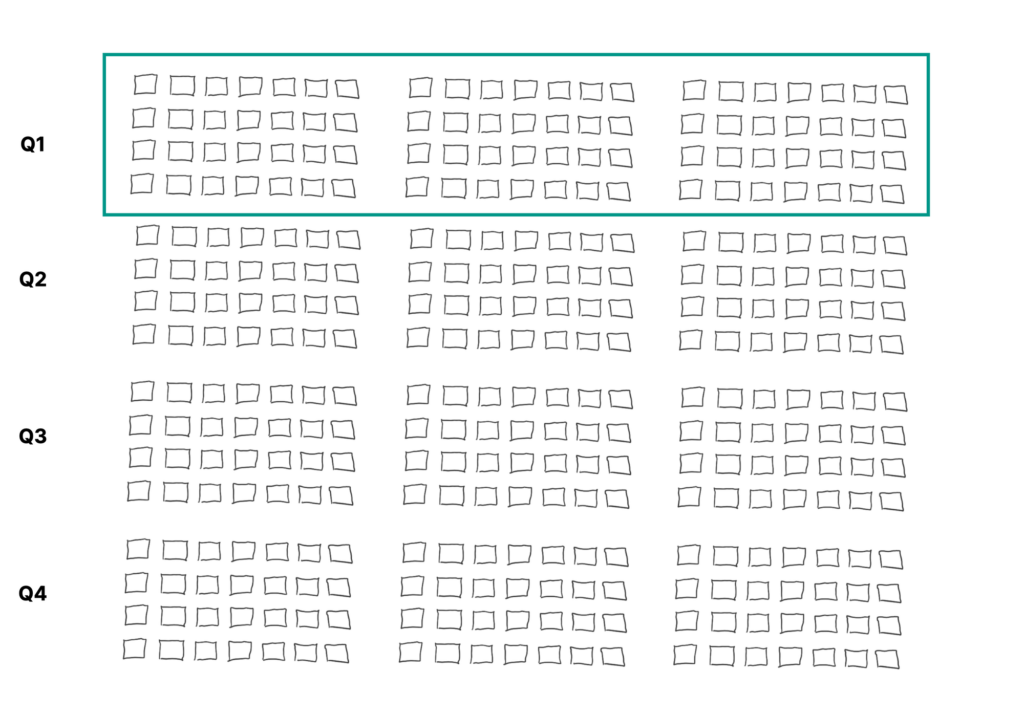
Using this process, I’ve been able to reach weight-loss goals and revenue goals for my business, write books, read large portions of the Scriptures, and systematically organize areas of my life. 12 to 13 weeks seems to be the perfect rhythm for goals.
We’ve also found the same to be true for many other believers. We introduced quarterly goal challenges to the Redeeming Productivity Academy last year, and we’ve just had story after story of people accomplishing huge goals with the proper ultimate object—God’s glory.
In this essay, I’ll be sharing our quarterly review and planning process.
Evaluate Your Progress
Looking ahead to the quarter always begins with looking back.
I start my planning process by reflecting on my purpose and long-term goals. This helps me see where the Lord is growing me. It also supplies me with clarity about which areas of my life need change.
First, I read my written vision statement for my life. I use what we call a “well done” statement. It’s just a brief encapsulation of what I believe faithfulness should look like in the six main domains of stewardship God has entrusted to me.
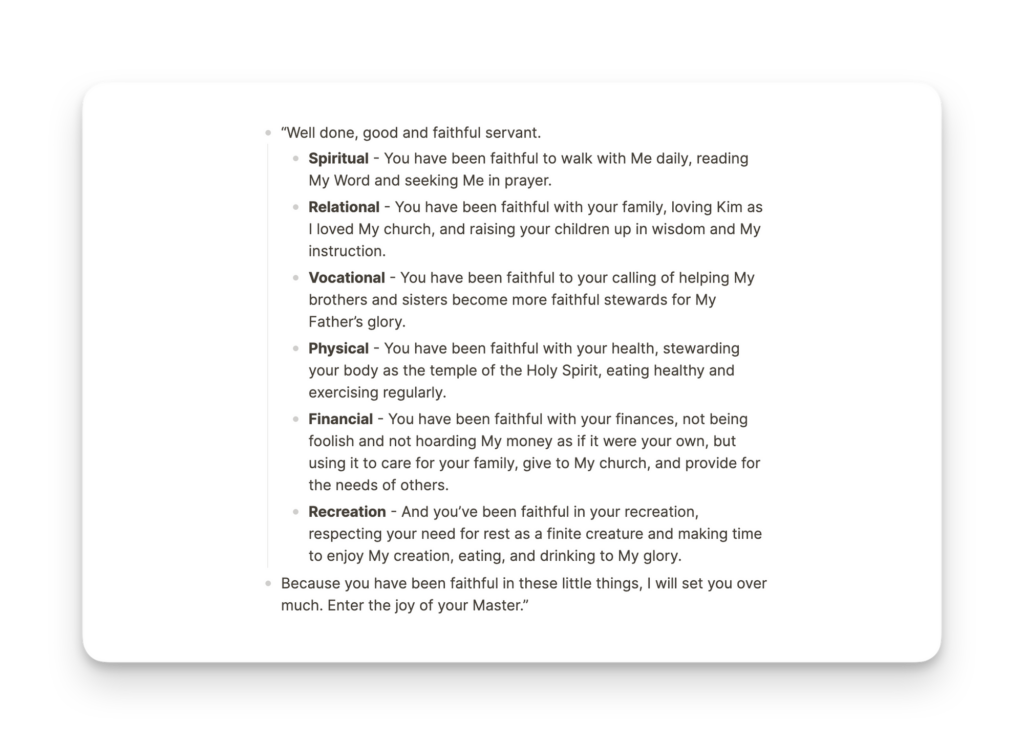
This is what I’m aiming my whole life at. It’s the big picture that day by day, I’m seeking, through the Spirit’s empowering, to bring my life more and more in alignment with.
If you don’t have something like this yet, you can begin your own planning process by thinking and praying through those six domains of stewardship.
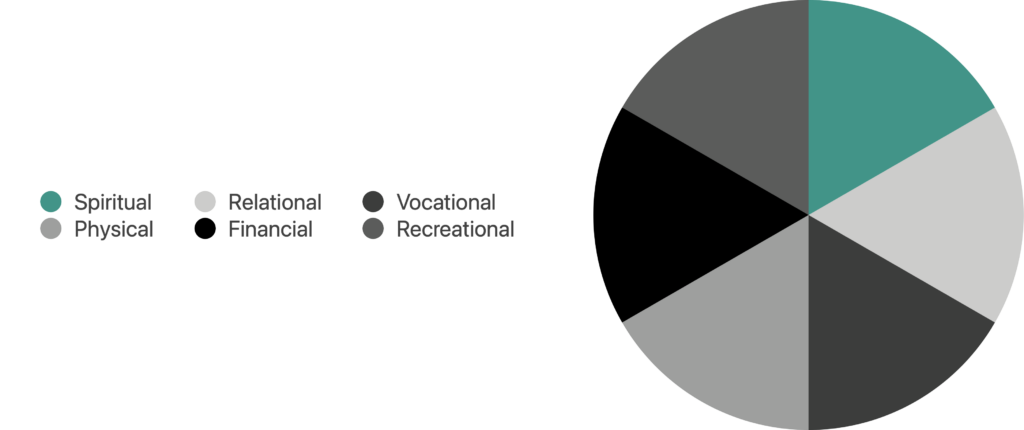
Ask yourself the following questions:
- What does faithfulness look like in this area?
- Where have I seen growth this past quarter?
- Where am I falling short?
After reflecting on how you’re doing in each area, give yourself a grade for each, 1 out of 5.
Here’s how I graded myself for this past quarter:
- Spiritual – 2/5
- Relational – 5/5
- Physical – 3/5
- Vocational – 5/5
- Recreational – 2/5
- Financial – 4/5
You’re not trying to be harsh with yourself; just honest about where things are going well and where you need improvement. If you have a believing spouse or close friend, it might be beneficial to share your results with them and get their take. We all have blind spots.
This evaluation phase aims to help you focus your actions in the coming quarter. We don’t want to choose just some random goal; we want to deliberately target the areas of our lives where we need to grow.
Select Your Big Goal
Now, it’s time to choose your goal for the quarter.
Indeed, there will be other things you’ll work on during these three months, but by selecting just one goal for the quarter, you’re saying to yourself, “Even if all my other plans fall apart, this is the one thing I’m going to stick with no matter what.”
But how do we choose the one goal?
1. Brainstorm Potential Goals
Take a piece of paper and start writing down every goal you might want to tackle this quarter. Use the domains of stewardship above as prompts (e.g. try to come up with some financial goals, physical goals, relational goals, etc.).
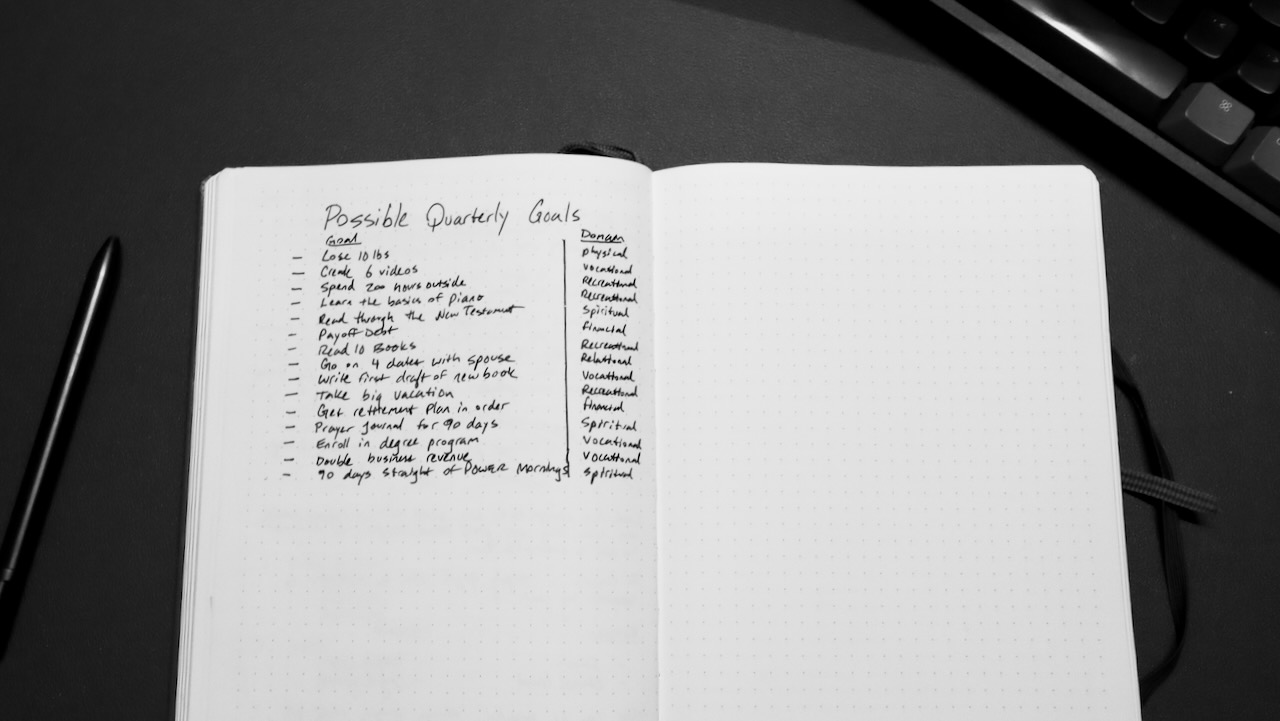
- Try to come up with 3–5.
- Make sure they’re challenging enough to dedicate three months to yet reasonably achievable.
- Think about where you’d like to be in five years and the type of goals that might help you get there.
- Ask, “What would most honor God in this season of life?”
After you have your list, categorize the goals using those stewardship domains discussed above.
2. Choose Just One Goal for the Quarter
Now that you’ve got a list of potential goals ask yourself:
“Based on my evaluation results, and current season of life, which of these goals will best help me glorify God, fulfill my purpose, and reach my long-term goals?”
Also, you don’t just have to choose a goal that relates to the area you scored the lowest. For example, last quarter, I graded myself as a two on the spiritual and recreational domains. I didn’t walk with the Lord as closely as I would have liked during the Summer, and I didn’t spend enough time resting or enjoying the things God has given me. So those would both be good candidates for a big goal. However, I felt that both of those deficiencies could be better addressed with small changes to my schedule and habits than they would with a big goal.
So, I decided to focus my quarterly goal on the physical domain of stewardship. I graded myself as a three in that area because I have not been as active as I need to be and gained some weight this past quarter.
I also felt that prioritizing my physical health would have great knock-on benefits for my other domains like more energy, better mood, and clearer thinking.
And lastly, a weight loss goal suited itself well to the length and format of a quarterly goal.
Now it was time to build my plan.
Break Your Goal Down
Once I set a weight loss goal and then turned to creating a plan for how to attack it over the next 13 weeks.
I think of my quarterly goals at three levels:
- The Goal – The big outcome itself
- The Waypoints – The monthly milestones
- The Oars – The habits or actions that will propel me
You want to break the big goal into smaller milestones and choose the habits or actions that will help you achieve the goal.
If you picture your quarter as a ship’s voyage, the goal is your destination, the X on your map. But it’s a long voyage. So, you need to decide where your first stop will be. This is your first month’s waypoint. You also need to figure out your method of propulsion. What are the oars—the habits and systems that will get you there?
But before we deal with waypoints and oars, we need to take one more pass at the goal. We want to make it so specific that there’s no question about where we’re heading.
1. Make Your Goal Hyper-Specific
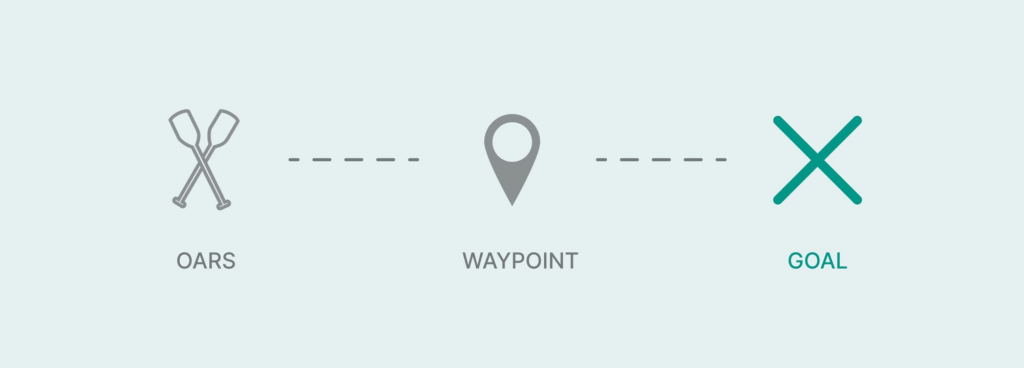
Usually, when you first write down your goal, it’s not very specific.
“Lose weight.”
- How much weight?
- By when?
- How are you going to do it?
A goal is simply a state or outcome you want to achieve. It helps to write exactly what that state or outcome will look like when you reach the goal. In other words, write your goal in the present tense as if you’ve already reached it. Try also to use numbers (make it quantifiable) if possible. And always include the deadline (in this case, the last day of the quarter). And state how doing this goal will bring glory to God.
Example: “I weigh 170 lbs 3 days by December 31st because I am called to be a responsible steward of my body for God’s glory.”
I haven’t left myself any wiggle room with that description. I’ll know at the end of the quarter whether I reached it or not. That’s precisely what you want: a hyper-specific goal.
2. Choose Your First Waypoint
Three months is still a long time, so next, I like to break my goal into a first milestone or waypoint. This helps me stay motivated. It also gives me the freedom to adjust course after the first month. Usually, after I’ve been rowing toward my goal for a month, I gain a lot more clarity about how best to reach it. So don’t plan all your waypoints out at once. Just choose a sort of mini-goal for the first month.
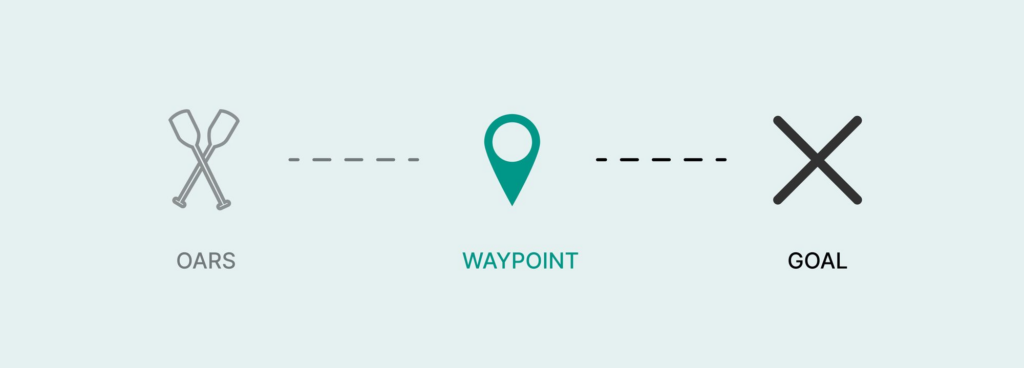
To choose a waypoint, do what you did with your goal and brainstorm 3–5 potential waypoints. Then, choose the one that you think makes the most sense to tackle first.
Example: For a quarterly goal of running a marathon, your first waypoint might be, “By the end of next month, I’ll have done an 8-mile run.”
And don’t toss the brainstorming list; you may draw from it for future waypoints in the coming months.
But for now, let’s choose the actions that will help you reach that waypoint.
3. Select Your Oars
Now that you have your goal clarified and your first waypoint chosen, it’s time to figure out how you’ll propel yourself toward that waypoint—and ultimately toward your goal.
Oars are simply the weekly or daily actions you’ll do that will bring you closer to the outcome you want.
You might have an excellent plan if you just plotted your goal and first waypoint. But that’s all it would be: a plan. Oars are where the action happens. Without them, you will never make progress.
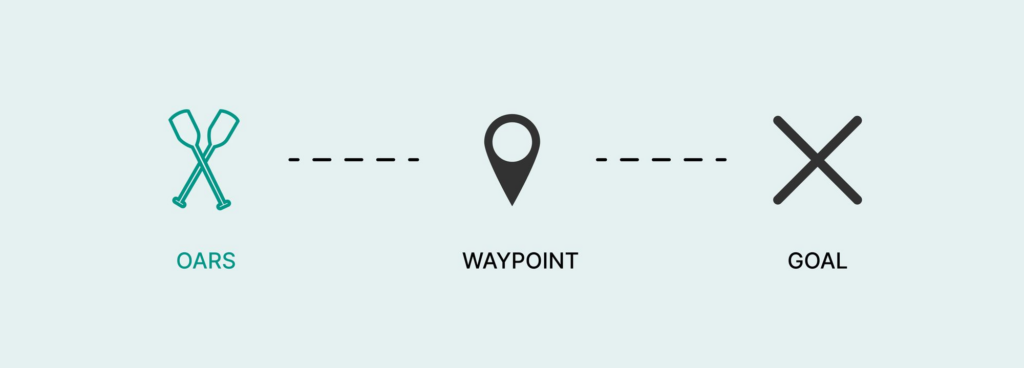
Here’s the question: “What is the one habit I will commit to in the first month of the quarter that will most effectively help me reach my waypoint?”
You’re not committing to a habit for three months. Just one. And if it is not helpful, you can make adjustments after month one. No pressure.
Again, it’s wise to brainstorm 3–5 potential oars.
Maybe for a weight-loss goal, you’d consider some of the following as potential oars:
- Daily calorie counting
- Daily weigh-ins
- 30-60 minute walk every weekday
- 3x a week weight training or HIIT following a home workout program.
But, again, don’t try to do them all!
You may begin to stack multiple habits or actions after the first month. But for now, choose only one.
The Focusing Question from The ONE Thing by Jay Papasan and Gary Keller is great for narrowing down the best oars.
For my part, I chose daily calorie counting and my oars for month one. Because if I’m not eating right, it doesn’t matter how much exercise I do. And if I know I’m eating well, I’ll actually want to look at the scale to see my progress.
It’s also wise to write your habit in the form of what James Clear, author of Atomic Habits, calls an “implementation intention.”
I will [BEHAVIOR] at [TIME] in [LOCATION]
Example: I will enter my meals in Nutritionix at 9 PM while brushing my teeth in the bathroom.
You can reinforce this by using alarms, calendar reminders, or building a daily schedule with your oars planned out.
3. Get Accountability
So now we’ve got a pretty good plan in place.
- Goal: A super clear outcome for the quarter
- Waypoint: A fixed milestone I’m aiming for in the first month
- Oars: An explicit, scheduled action to help me get there
For some people, this is all they need. Their internal motivation is so high that it just takes a good plan. But for others of us, we need a bit more help.
Anyone who has ever had a gym partner knows that having accountability increases consistency. It’s the same for any goal, not just exercise. Having someone who is in it with you can make all the difference in the world.
So try to find someone to stay accountable with. They don’t have to be doing the same goal, but it’s best if they are pursuing some goal. Then, it’s mutually beneficial.
Just create a schedule to check in with each other to ensure you’re both staying the course. Could be as simple as a weekly text.
What if you don’t have someone to keep you accountable?
If you read this whole essay and think, “I want to put this into action, but I’m not confident I’ll stick with it, and there’s not someone in my life to help me stay accountable,” then you’re the type of person we designed Redeeming Productivity Academy for.
Besides having a ton of courses that teach productivity principles from a Christian worldview, Redeeming Productivity Academy is an online community for productivity-minded believers. And the main thing we do in that community is help each other set and reach quarterly goals for the glory of God.
In fact, next Tuesday, September 26th, we’re hosting our 2023 Q4 Planning Workshop, where we’ll be helping members through this process of God-honoring goals for the quarter. Members will work with me and our head productivity coach, James Parker, to clarify your quarterly goal and break it down into waypoints and oars. Then, throughout the next three months, we’ll help you stay accountable with weekly check-ins, monthly waypoint-setting calls, and tons of encouragement, pointing you back to the big picture—you’re doing this not just for yourself but to bring God glory by being a faithful steward.
Conclusion
Imagine if you were knocking out four huge goals every year specifically targeted to help you grow in faithfulness in the areas of your life where you’re lacking. Think of how fundamentally your life would change in just a year. Quarterly goals can help you get there.
And if you want some more help with this, click here to learn more about Redeeming Productivity Academy. We also have 1-on-1 coaching options if you want even more personalized help.

